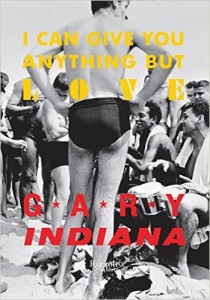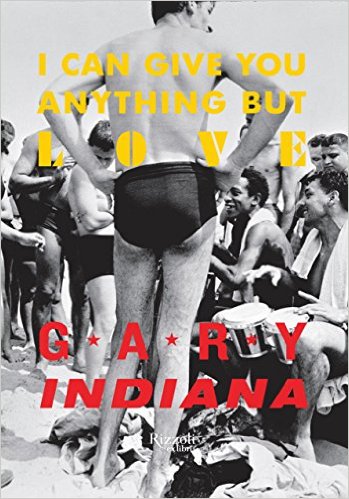 I Can Give You Anything But Love
I Can Give You Anything But Love
by Gary Indiana
Rizzoli Ex Libris. 240 pages, $25.95
“I’M OLD ENOUGH to justify writing about my history,” Gary Indiana remarks early on in his new memoir, “but too old to remember much of it.” That disclaimer notwithstanding, Indiana has written a very good book. At 65, he has a large body of work behind him: seven novels; three collections of short fiction, poems, and plays; and numerous nonfiction books, including a trilogy based on famous criminals (among them Gianni Versace’s killer, Andrew Cunanan, and twin murderers Lyle and Erik Menendez). Indiana is a well-regarded critic; he has acted in independent films; his visual art has had solo shows in New York and L.A. and was included in the 2014 Whitney Biennial. He has plenty of good stories to tell.
I Can Give You Anything But Love begins in Havana, where Indiana has lived for many years. He writes reverently of his life there—his neighborhood, the quirks of the city, and the erotic appeal of Cuban men. “Cuban men will screw a grapefruit,” he says, summing up the abundance of sexual opportunities on the island. The book is only loosely chronological; each chapter begins in Cuba but then veers into the past. His disdain for childhood recollections is evident in how he reckons with coming of age in New Hampshire. These sections read like prose poetry. Extended reflection is limited. Instead, he offers snippets of family lore, period details, a catalogue of early sexual adventures, and cultural and historical reference points. One is reminded of Joe Brainard’s evocative, book-length list, I Remember (1975).
He gets out of New Hampshire quickly. California beckons, and his account of his time in late-’60s, early-’70s San Francisco is a lively one. It includes behind-the-camera work in the porn industry, a regular routine of shoplifting and drug transactions, and vague associations with gangsters, pushers, and similar characters. Janis Joplin makes an appearance. There’s a story of how Beat writer and City Lights Books founder Lawrence Ferlinghetti, mistaking Indiana for a woman, takes him out on a date and then ends it gracefully when he realizes his error. At Berkeley, Indiana meets art porn filmmaker Ferd Eggan, who becomes his first real love and a lifelong friend, and who figures prominently in the book. Indiana shares a house in San Francisco’s Haight-Ashbury district with a colorful cast of characters. Most of the memories are good, but in one harrowing scene he’s brutally raped by a Hell’s Angel biker in the basement while Ferd’s wedding takes place upstairs. A nervous breakdown follows.
Indiana offers equally compelling tales from his interludes in L.A. in the ’70s and New York City in the ’80s, as well as his travels abroad. There’s plenty of sex, a lot of drugs, and even a near fatal car crash. His account of his L.A. years in an old apartment building, the Bryson, reads like Nathanael West’s The Day of the Locust. Indiana’s writing about the Bryson in particular, and L.A. in general, has a plaintive tone. It’s a lament for the city as it used to be and is no longer, and this theme runs through the book, whether the subject is Havana, New York City, or any of the other places that the writer has known and loved.
Indiana takes the opportunity to settle some scores, literary and otherwise. He questions the veneration of canonical writers like Hemingway and F. Scott Fitzgerald, and contemporaries like Joyce Carol Oates. He offers a memorable and scathing assessment of Susan Sontag, with whom he endured a troubled friendship, one that ended when Sontag inexplicably dropped him, as she did many others. Participating in a PEN writing panel with Kathy Acker, Indiana recounts their dislike of a bloviating fellow panelist, referred to as “Bertie Wooster” (who must be William Vollman, unless I miss my guess). And there’s an intriguing and very unflattering account of Indiana’s interview with director David Lynch.
Indiana is adept at painting richly detailed scenes and passing moments, weaving in recollections, history, and personal revelations in a way that recalls the semi-autobiographical novels of W. G. Sebald. Indeed, Indiana speaks admiringly of Sebald’s Vertigo, and, as Sebald does as well, Indiana peppers his book with uncaptioned photographs (most of which seem only vaguely related to the text, but which are nonetheless enchanting). In the closing sentences of this entertaining, endearing, and honest book, Indiana is resigned to having lived a life that “has not, in any case, been an unmitigated triumph over adversity.” Perhaps that’s true, but this has not prevented him from creating something of lasting value for his readers.
________________________________________________________
Jim Nawrocki, a longtime G&LR contributor, lives in San Francisco.






